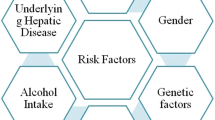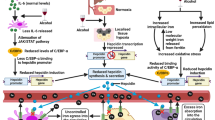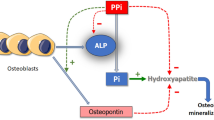Abstract
Medically diagnosed alcoholics can be differentiated reliably from non-alcoholics using clinically laboratory tests. In the present study, patients with liver diseases either due to alcohol or without alcohol compared with a group of normal healthy persons. Heavy drinkers showed significantly lower body weight and percent body fat, and low BMI compared with other groups. The percentage of hemoglobin and total number of RBC were found to be significantly decreased, whereas mean corpuscular volume (MCV) significantly increased in alcoholic liver disease (ALD). Hyperbilirubinemia, hyperuricemia and hypoalbuminemia correlate with alcohol intake. Albumin/globulin ratio significantly decreased in ALD. In acute liver injury AST/ALT ratio is ≤1.0, whereas in alcoholic hepatitis it is always >1.0. Moderately elevated level of ALP and high GGT values are good discriminator of alcoholic patients. Alcohol-induced liver injury is linked to oxidative stress as observed by decreased level of reduced glutathione and ascorbic acid, and increased level of thiobarbituric acid reactive substances.
Similar content being viewed by others
References
Gyatso, TR., Bagdas, BB; (1998) In: Health Status In Sikkim. (Dept. of Health and Family Welfare, Govt. of Sikkim).
Nevins, C.L.; Malaty, H.; Velez, M.E.; Anand, B.S. (1999) Interaction of alcohol and hepatitis C virus infection on severity of liver disease. Dig Dis and Sci, 1236–1242.
Bellentani, S., Saccocio, G., Masutti, F., Giacca, M., Miglioli, L., Monzoni, A., Tiribelli, C.; (2000) Risk factors for alcoholic liver disease. Addiction Biology, 5(3), 261–268.
Fickert, P., Zatloukal, K., (2000) Pathogenesis of alcoholic liver disease. In: Handbook of Alcoholism (Eds. G. Zemig, A. Saria, M. Kurz, and S.S. O’Malley) Boca Raton, FL: CRC Press, 317–323.
Das SK, Nayak P, Vasudevan DM (2003) Biochemical markers of alcohol consumption. Ind J Clin Biochem. 18(2), 111–118.
Chalmers DM, Grinsler MG, MacDermott S, Spicer CC, Levi AJ (1981) Biochemical and haematological indicators of excessive alcohol consumption. Gut, 22, 992–996.
Paton A (1994) Asking the right questions. In: ABC of Alcohol, Ed. A. Paton, BMJ Publishing Group, Tavistock square, London. p.14.
Foster DW (1992). Eating disorders: obesity, anorexia nervosa and Bullimina nervosa. In: Williams Textbook of Endocrinology; 8th Edn. W.B.Saunders (Eds. J.W. Wilson and D.W. Foster) p.1336.
van Kampen EJ, Zijlstra WG (1965) Determination of hemoglobin and its derivatives. Adv Clin Chem, 8, 141–187.
Tiffany TO, Jansen JM, Burtis CA,et al (1972) Enzymatic kinetic rate and endpoint analysis of substrate by use of GEMSAEC fast analyzer. Clin Chem, 18, 829.
Larsen K (1972) Creatinine assay by a reaction kinetic principle. Clin Chem Acta, 41, 209.
Gochman N, Schmitz JM (1971) Automated determination of uric acid with use of a uricase-peroxidase system. Clin Chem, 17, 1154.
Jendrassik, L., Grof, P. (1938) Biochem Z, 297, 81.
Doumas BT, Peter T, Jr. (1997) Serum and urine albumin: a progress report on their measurement and clinical significance. Clin Chim Acta, 258, 3–20.
Kingsley GR (1942) The direct biuret method for the determination of serum proteins as applied to photoelectric and visual colorimetry. J Lab Clin Med, 27, 840–845.
Linhardt K, Walter K (1963). Phosphatase. In: Methods of Enzymatic Analysis (Ed. Bergmeyer HU) Academic Press, New York, p.799.
Bergmeyer HU, Bernt E (1963) Glutamate oxaloacetate transaminase; Glutamate pyruvate transaminase. In: Methods of Enzymatic Analysis (Ed. Bergmeyer HU) Academic Press, New York, pp.837–853.
Gowelock, A.H. (1988) In: Varley’s Practical Clinical Biochemistry. 6th edn. Heinemann Professional Publishing, p.519
McCormick DB, Greene HL (1998). Vitamin. In: Tietz Textbook of Clinical Chemistry. (Eds. CA Burtis and ER Ashwood) W.B. Saunders Company, USA. p.1025.
Sinnhuber RO, Yu TC, Yu TC (1958) Characterization of the red pigment formed in the thiobarbituric acid determination of oxidative rancidity. Food Res, 23, 626–630.
Beutler E, Duron O and Kelly BM (1963) Improved method for determination of blood glutathione. J Lab Clin Med, 61, 882–888.
Addolorato G, Capristo E, Greco AV, Stefanini GF, Gasbarrini G (1998) Influence of chronic alcohol abuse on body weight and energy metabolism: is excess ethanol consumption a risk factor for obesity or malnutrition? J Intern Med, 244(5), 387–395
World MJ, Ryle PR, Jones D, Shaw GK, Thomson AD (1984) Differential effect of chronic alcohol intake and poor nutrition on body weight and fat stores. Alcohol Alcohol, 19(4), 281–290
Addolorato G, Capristo E, Marini M, Santini P, Scognamiglio U, Attilia ML, Messineo D, Sasso GF, Gasbarrini G, Ceccanti M. (2000) Body composition changes induced by chronic ethanol abuse: evaluation by dual energy X-ray absorptiometry. Am J Gastroenterol, 95(9), 2323–2327
Nordmann R, Rouach H (1996) Alcohol and free radicals: from basic research to clinical prospects. Gastroenterol Hepatol, 32(3), 128–133.
Whitfield JB, Hensley WJ, Bryden D, Gallagher H (1978) Some laboratory correlates of drinking habits. Annals Clin Biochem, 15, 297–303.
Ahlgren A, Hedenborg G, Norman A, Wisen O. (1988) Serum bilirubin subfractions in patients with alcohol abuse during detoxication. Scand J Clin Lab Invest, 48(4), 319–26
Annoni G, Arosio B, Santambrogio D, Gagliano N, Zem MA (1991) Albumin and procollagen type I gene regulation in alcohol and viral-induced human liver disease. Boll Ist Sieroter Milan, 70(1–2), 391–397.
Oratz M, Rothschild MA, Schreiber SS (1976) Alcohol, amino acids, and albumin synthesis. II. Alcohol inhibition of albumin synthesis reversed by arginine and spermine. Gastroenterology; 71(1), 123–127.
Waern AU, Hellsing K (1980) Indices of alcohol intake. Comparison between serum concentrations of alkaline phosphatase and gamma glutamyltransferase in middle-aged men. Ups J Med Sci, 85(2), 159–163.
Schimdt E, Schimdt FW (1979) Enzyme diagnosis in diseases of the liver and biliary system. In: Advances in Clinical Enzymology. Vol.I. (Eds. E Schimdt, FW Schimdt, I Trautschold, R Friedel) Basel: Karger; pp. 232–292.
Nalpas B, Vassault A, LeGuillou A et al (1984) Serum activity of mitochondrial aspartate amino transferase: a sensitivity marker of alcoholism with or without alcoholic hepatitis. Hepatology, 4, 893–896.
Krastev Z, Mateva L, Danev S, Nikolov R (1992) clinical meaning of GGT activity in follow-up of patients with alcohol-related liver injury and cholestasis. Ital J Gastroenterol, 24(4), 185–187
Rosalki S (1984) Identifying the alcoholic. In Clinical Biochemistry of Alcoholism, (Ed. Rosalki S) Churchill, Livingstone, Edinburgh 65–92.
Daeppen JB, Schoenfeld-Smith K, Smith TL, Schuckit MA. (1999) Characteristics of alcohol dependent subjects with very elevated levels of Gamma-Glutamyltransferase (GGT). J Stud Alcohol, 60(5), 589–594
Chandra R, Aneja R, Rewal C, Konduri R, Dass SK, Agarwal S (2000) An opium alkaloid-Papaverine ameliorates ethanol-induced hepatotoxicity: diminution of oxidative stress. Ind J Clin Biochem, 15(2), 155–160.
Minor T, Isselhard W (1993) Role of the hepato vasculature in free radical mediated reperfusion damage of the liver. Eur Surg Res, 25(5), 287–293.
Videla LA, Iturriaga H, Pino ME, Bunout D, Valenzuela A, Ugarte G (1984) Content of hepatic reduced glutathione in chronic alcoholic patients: influence of the length of the abstinence and liver necrosis. Clin Sci, 66, 283–290.
Author information
Authors and Affiliations
Corresponding author
Rights and permissions
About this article
Cite this article
Das, S.K., Vasudevan, D.M. Biochemical diagnosis of alcoholism. Indian J Clin Biochem 20, 35–42 (2005). https://doi.org/10.1007/BF02893039
Issue Date:
DOI: https://doi.org/10.1007/BF02893039




